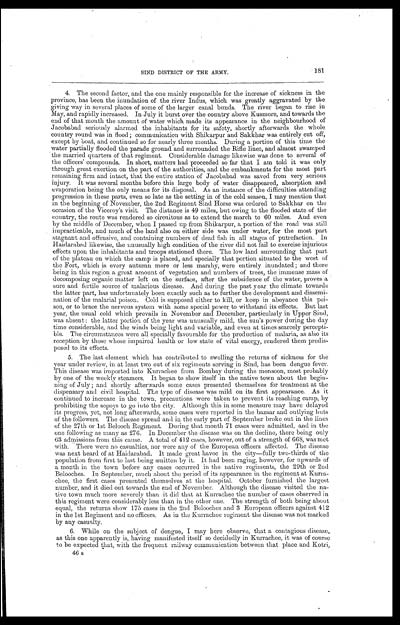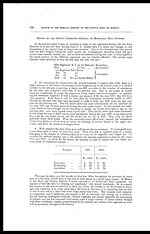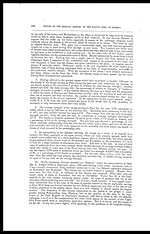Medicine - Institutions > Army health reports and medical documents > Sketch of the medical history of the native army of Bombay > Sketch of the medical history of the native army of Bombay, for the year 1872
(190) Page 181
Download files
Individual page:
Thumbnail gallery: Grid view | List view

181
SIND DISTRICT OF THE ARMY.
4. The second factor, and the one mainly responsible for the increase of sickness in the
province, has been the inundation of the river Indus, which was greatly aggravated by the
giving way in several places of some of the larger canal bunds. The river began to rise in
May, and rapidly increased. In July it burst over the country above Kusmore, and towards the
end of that month the amount of water which made its appearance in the neighbourhood of
Jacobabad seriously alarmed the inhabitants for its safety, shortly afterwards the whole
country round was in flood; communication with Shikarpur and Sakkhar was entirely cut off,
except by boat, and continued so for nearly three months. During a portion of this time the
water partially flooded the parade ground and surrounded the Rifle lines, and almost swamped
the married quarters of that regiment. Considerable damage likewise was done to several of
the officers' compounds. In short, matters had proceeded so far that I am told it was only
through great exertion on the part of the authorities, and the embankments for the most part
remaining firm and intact, that the entire station of Jacobabad was saved from very serious
injury. It was several months before this large body of water disappeared, absorption and
evaporation being the only means for its disposal. As an instance of the difficulties attending
progression in these parts, even so late as the setting in of the cold season, I may mention that
in the beginning of November, the 2nd Regiment Sind Horse was ordered to Sakkhar on the
occasion of the Viceroy's visit. The distance is 49 miles, but owing to the flooded state of the
country, the route was rendered so circuitous as to extend the march to 60 miles. And even
by the middle of December, when I passed up from Shikarpur, a portion of the road was still
impracticable, and much of the land also on either side was under water, for the most part
stagnant and offensive, and containing numbers of dead fish in all stages of putrefaction. In
Haidarabad likewise, the unusually high condition of the river did not fail to exercise injurious
effects upon the inhabitants and troops stationed there. The low land surrounding that part
of the plateau on which the camp is placed, and specially that portion situated to the west of
the Fort, which is every autumn more or less marshy, were entirely inundated; and there
being in this region a great amount of vegetation and numbers of trees, the immense mass of
decomposing organic matter left on the surface, after the subsidence of the water, proves a
sure and fertile source of malarious disease. And during the past year the climate towards
the latter part, has unfortunately been exactly such as to further the development and dissemi-
nation of the malarial poison. Cold is supposed either to kill, or keep in abeyance this poi-
son, or to brace the nervous system with some special power to withstand its effects. But last
year, the usual cold which prevails in November and December, particularly in Upper Sind,
was absent: the latter portion of the year was unusually mild, the sun's power during the day
time considerable, and the winds being light and variable, and even at times scarcely percepti-
ble. The circumstances were all specially favourable for the production of malaria, as also its
reception by those whose impaired health or low state of vital energy, rendered them predis-
posed to its effects.
5. The last element which has contributed to swelling the returns of sickness for the
year under review, in at least two out of six regiments serving in Sind, has been dengue fever.
This disease was imported into Kurrachee from Bombay during the monsoon, most probably
by one of the weekly steamers. It began to show itself in the native town about the begin-
ning of July; and shortly afterwards some cases presented themselves for treatment at the
dispensary and civil hospital. The type of disease was mild on its first appearance. As it
continued to increase in the town, precautions were taken to prevent its reaching camp, by
prohibiting the sepoys to go into the city. Although this in some measure may have delayed
its progress, yet, not long afterwards, some cases were reported in the bazaar and outlying huts
of the followers. The disease spread and in the early part of September broke out in the lines
of the 27th or 1st Belooch Regiment. During that month 71 cases were admitted, and in the
one following as many as 276. In December the disease was on the decline, there being only
63 admissions from this cause. A total of 412 cases, however, out of a strength of 668, was met
with. There were no casualties, nor were any of the European officers affected. The disease
was next heard of at Haidarabad. It made great havoc in the city—fully two-thirds of the
population from first to last being smitten by it. It had been raging, however, for upwards of
a month in the town before any cases occurred in the native regiments, the 29th or 2nd
Belooches. In September, much about the period of its appearance in the regiment at Kurra-
chee, the first cases presented themselves at the hospital. October furnished the largest
number, and it died out towards the end of November. Although the disease visited the na-
tive town much more severely than it did that at Kurrachee the number of cases observed in
this regiment were considerably less than in the other one. The strength of both being about
equal, the returns show 175 cases in the 2nd Belooches and 3 European officers against 412
in the 1st Regiment and no officers. As in the Kurrachee regiment the disease was not marked
by any casualty.
6. While on the subject of dengue, I may here observe, that a contagious disease,
as this one apparently is, having manifested itself so decidedly in Kurrachee, it was of course
to be expected that, with the frequent railway communication between that place and Kotri,
46 s
Set display mode to: Large image | Zoom image | Transcription
Images and transcriptions on this page, including medium image downloads, may be used under the Creative Commons Attribution 4.0 International Licence unless otherwise stated. ![]()
| Permanent URL | https://digital.nls.uk/75013208 |
|---|




